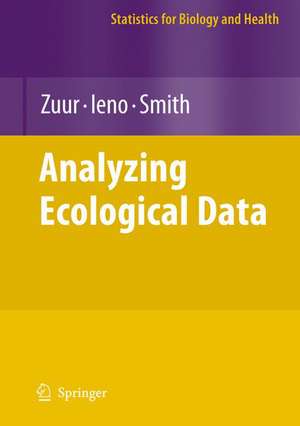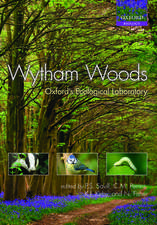Analyzing Ecological Data: Statistics for Biology and Health
Autor Alain Zuur, Elena N. Ieno, Graham M. Smithen Limba Engleză Hardback – 3 mai 2007
| Toate formatele și edițiile | Preț | Express |
|---|---|---|
| Paperback (1) | 1124.92 lei 6-8 săpt. | |
| Springer – 11 feb 2011 | 1124.92 lei 6-8 săpt. | |
| Hardback (1) | 1379.34 lei 3-5 săpt. | +44.06 lei 4-10 zile |
| Springer – 3 mai 2007 | 1379.34 lei 3-5 săpt. | +44.06 lei 4-10 zile |
Din seria Statistics for Biology and Health
- 20%
 Preț: 633.23 lei
Preț: 633.23 lei -
 Preț: 545.57 lei
Preț: 545.57 lei - 17%
 Preț: 352.01 lei
Preț: 352.01 lei - 20%
 Preț: 758.04 lei
Preț: 758.04 lei - 18%
 Preț: 1394.84 lei
Preț: 1394.84 lei - 18%
 Preț: 883.59 lei
Preț: 883.59 lei - 5%
 Preț: 843.91 lei
Preț: 843.91 lei -
 Preț: 397.16 lei
Preț: 397.16 lei - 20%
 Preț: 1002.67 lei
Preț: 1002.67 lei - 15%
 Preț: 657.39 lei
Preț: 657.39 lei - 18%
 Preț: 960.93 lei
Preț: 960.93 lei - 5%
 Preț: 852.69 lei
Preț: 852.69 lei - 18%
 Preț: 903.62 lei
Preț: 903.62 lei - 5%
 Preț: 721.40 lei
Preț: 721.40 lei - 18%
 Preț: 2114.90 lei
Preț: 2114.90 lei - 15%
 Preț: 653.46 lei
Preț: 653.46 lei - 18%
 Preț: 1395.32 lei
Preț: 1395.32 lei - 5%
 Preț: 1102.10 lei
Preț: 1102.10 lei - 5%
 Preț: 874.83 lei
Preț: 874.83 lei - 18%
 Preț: 1108.99 lei
Preț: 1108.99 lei - 5%
 Preț: 821.39 lei
Preț: 821.39 lei - 5%
 Preț: 849.02 lei
Preț: 849.02 lei - 15%
 Preț: 653.14 lei
Preț: 653.14 lei - 18%
 Preț: 943.22 lei
Preț: 943.22 lei - 5%
 Preț: 1092.43 lei
Preț: 1092.43 lei - 15%
 Preț: 594.21 lei
Preț: 594.21 lei - 5%
 Preț: 377.87 lei
Preț: 377.87 lei - 18%
 Preț: 1124.60 lei
Preț: 1124.60 lei - 18%
 Preț: 1220.12 lei
Preț: 1220.12 lei - 15%
 Preț: 632.98 lei
Preț: 632.98 lei - 18%
 Preț: 958.56 lei
Preț: 958.56 lei - 5%
 Preț: 722.69 lei
Preț: 722.69 lei - 18%
 Preț: 728.74 lei
Preț: 728.74 lei - 18%
 Preț: 1394.84 lei
Preț: 1394.84 lei -
 Preț: 389.11 lei
Preț: 389.11 lei - 18%
 Preț: 959.98 lei
Preț: 959.98 lei
Preț: 1379.34 lei
Preț vechi: 1724.18 lei
-20% Nou
Puncte Express: 2069
Preț estimativ în valută:
264.00€ • 272.07$ • 222.88£
264.00€ • 272.07$ • 222.88£
Carte disponibilă
Livrare economică 11-25 februarie
Livrare express 25-31 ianuarie pentru 54.05 lei
Preluare comenzi: 021 569.72.76
Specificații
ISBN-13: 9780387459677
ISBN-10: 0387459677
Pagini: 672
Ilustrații: XXVI, 672 p.
Dimensiuni: 155 x 235 x 43 mm
Greutate: 1.13 kg
Ediția:2007
Editura: Springer
Colecția Springer
Seria Statistics for Biology and Health
Locul publicării:New York, NY, United States
ISBN-10: 0387459677
Pagini: 672
Ilustrații: XXVI, 672 p.
Dimensiuni: 155 x 235 x 43 mm
Greutate: 1.13 kg
Ediția:2007
Editura: Springer
Colecția Springer
Seria Statistics for Biology and Health
Locul publicării:New York, NY, United States
Public țintă
ResearchCuprins
Data management and software.- Advice for teachers.- Exploration.- Linear regression.- Generalised linear modelling.- Additive and generalised additive modelling.- to mixed modelling.- Univariate tree models.- Measures of association.- Ordination — First encounter.- Principal component analysis and redundancy analysis.- Correspondence analysis and canonical correspondence analysis.- to discriminant analysis.- Principal coordinate analysis and non-metric multidimensional scaling.- Time series analysis — Introduction.- Common trends and sudden changes.- Analysis and modelling of lattice data.- Spatially continuous data analysis and modelling.- Univariate methods to analyse abundance of decapod larvae.- Analysing presence and absence data for flatfish distribution in the Tagus estuary, Portugal.- Crop pollination by honeybees in Argentina using additive mixed modelling.- Investigating the effects of rice farming on aquatic birds with mixed modelling.- Classification trees and radar detection of birds for North Sea wind farms.- Fish stock identification through neural network analysis of parasite fauna.- Monitoring for change: Using generalised least squares, non-metric multidimensional scaling, and the Mantel test on western Montana grasslands.- Univariate and multivariate analysis applied on a Dutch sandy beach community.- Multivariate analyses of South-American zoobenthic species — spoilt for choice.- Principal component analysis applied to harbour porpoise fatty acid data.- Multivariate analyses of morphometric turtle data — size and shape.- Redundancy analysis and additive modelling applied on savanna tree data.- Canonical correspondence analysis of lowland pasture vegetation in the humid tropics of Mexico.- Estimating common trends in Portuguese fisherieslandings.- Common trends in demersal communities on the Newfoundland-Labrador Shelf.- Sea level change and salt marshes in the Wadden Sea: A time series analysis.- Time series analysis of Hawaiian waterbirds.- Spatial modelling of forest community features in the Volzhsko-Kamsky reserve.
Recenzii
From the reviews:
"I liked the compact style of the book and really enjoyed the case studies. The book would be a suitable companion to statistics courses for both ecologists and statisticians at the introductory graduate level….All in all, I enjoyed reading the book and marvel at the wide range of sophisticated statistical models used in modern ecology."(Biometrics, 64, March 2008)
"Readership: Undergraduates, postgraduates and scientists engaged in areas of the environmental sciences and ecological research. The material presented in this book has been developed and used by the authors in teaching statistics to its intended readership. The text is divided into two parts … . I have no doubt that for undergraduate students the main strength of the book will be the breadth of topics covered by the case studies – ranging from terrestrial ecology to marine biology." (C. M. O’Brien, International Statistical Review, Vol. 75 (3), 2007)
"This is a practical way of analysing ecological data in which methodological approaches are combined with real data sets with the advantages and disadvantages of each strategy discussed. Who is it for? Upper undergraduates, postgraduates and researchers in ecology. Presentation It links ecological data, data analysis and discussion of the approaches. Would you recommend it? If you want an edited volume on different methods of ecological data analysis, then this book is worth looking through." (Times Higher Education, May, 2008)
"The book is aimed at three types of readers: ecologists who wish to develop their own statistical skills, quantitative ecologists who want to use more advanced techniques, and statistical scientists seeking more experience analyzing ecological data. … Enjoyable aspects of the book include good graphical outputs, with interpretations, in the text. … Overall, this book is wroth the purchase price … . No other book combines as many good ecological data sets with suchthoughtfully written analyses. I give this book two enthusiastic thumbs up!" (Loveday Conquest, Journal of the American Statistical Asociation, Vol. 103 (483), September, 2008)
"The book aims to give readers sufficient information to apply statistical methodology in a correct and useful way. … the book meets its aim, covering a wide range of statistical techniques and dealing with many situations that are encountered in ecological statistics. This is an excellent, nicely presented and very readable book. I would highly recommend it to numerate researchers and students interested in environment and ecological data analysis." (Weiqi Luo, Journal of Applied Statistics, Vol. 36 (2), February, 2009)
"Analysing Ecological Data by a group of ecologists-gone-statisticians from Scotland is the latest book in this area and based on years of teaching and consultancy experience. … The book differs from many of its competitors in its structure: it contains a general introduction to several fields of descriptive ecological data analysis (370 pages), which is augmented with 17 chapter-length case studies … . In summary, I can recommend the book primarily as advanced material for ecologists … ." (Carsten F. Dormann, Basic and Applied Ecology, Vol. (10), 2009)
"I liked the compact style of the book and really enjoyed the case studies. The book would be a suitable companion to statistics courses for both ecologists and statisticians at the introductory graduate level….All in all, I enjoyed reading the book and marvel at the wide range of sophisticated statistical models used in modern ecology."(Biometrics, 64, March 2008)
"Readership: Undergraduates, postgraduates and scientists engaged in areas of the environmental sciences and ecological research. The material presented in this book has been developed and used by the authors in teaching statistics to its intended readership. The text is divided into two parts … . I have no doubt that for undergraduate students the main strength of the book will be the breadth of topics covered by the case studies – ranging from terrestrial ecology to marine biology." (C. M. O’Brien, International Statistical Review, Vol. 75 (3), 2007)
"This is a practical way of analysing ecological data in which methodological approaches are combined with real data sets with the advantages and disadvantages of each strategy discussed. Who is it for? Upper undergraduates, postgraduates and researchers in ecology. Presentation It links ecological data, data analysis and discussion of the approaches. Would you recommend it? If you want an edited volume on different methods of ecological data analysis, then this book is worth looking through." (Times Higher Education, May, 2008)
"The book is aimed at three types of readers: ecologists who wish to develop their own statistical skills, quantitative ecologists who want to use more advanced techniques, and statistical scientists seeking more experience analyzing ecological data. … Enjoyable aspects of the book include good graphical outputs, with interpretations, in the text. … Overall, this book is wroth the purchase price … . No other book combines as many good ecological data sets with suchthoughtfully written analyses. I give this book two enthusiastic thumbs up!" (Loveday Conquest, Journal of the American Statistical Asociation, Vol. 103 (483), September, 2008)
"The book aims to give readers sufficient information to apply statistical methodology in a correct and useful way. … the book meets its aim, covering a wide range of statistical techniques and dealing with many situations that are encountered in ecological statistics. This is an excellent, nicely presented and very readable book. I would highly recommend it to numerate researchers and students interested in environment and ecological data analysis." (Weiqi Luo, Journal of Applied Statistics, Vol. 36 (2), February, 2009)
"Analysing Ecological Data by a group of ecologists-gone-statisticians from Scotland is the latest book in this area and based on years of teaching and consultancy experience. … The book differs from many of its competitors in its structure: it contains a general introduction to several fields of descriptive ecological data analysis (370 pages), which is augmented with 17 chapter-length case studies … . In summary, I can recommend the book primarily as advanced material for ecologists … ." (Carsten F. Dormann, Basic and Applied Ecology, Vol. (10), 2009)
Notă biografică
Grad students, researchers
Textul de pe ultima copertă
This book provides a practical introduction to analysing ecological data using real data sets collected as part of postgraduate ecological studies or research projects.
The first part of the book gives a largely non-mathematical introduction to data exploration, univariate methods (including GAM and mixed modelling techniques), multivariate analysis, time series analysis (e.g. common trends) and spatial statistics. The second part provides 17 case studies, mainly written together with biologists who attended courses given by the first authors. The case studies include topics ranging from terrestrial ecology to marine biology. The case studies can be used as a template for your own data analysis; just try to find a case study that matches your own ecological questions and data structure, and use this as starting point for you own analysis. Data from all case studies are available from www.highstat.com. Guidance on software is provided in Chapter 2.
Alain Zuur is senior statistician and director of Highland Statistics Ltd., a statistical consultancy company based in the UK. He has contributed to a wide range of projects related to marine biology, oceanography, ecology, fisheries, etc. and has extensive experience teaching statistics to ecologists and environmental scientists in the form of academic and non-academic courses. He is honorary research fellow in the School of Biological Sciences, Oceanlab, at the University of Aberdeen, UK.
Elena Ieno is senior marine biologist at Highland Statistics Ltd. In 2004 she left academia to work full time in statistical consultancy. She now teaches statistics to ecologists and has shown she can bridge the gap between the two disciplines and dispel the dread of statistics shown by most biologists. She is also involved in various international statistical consultancy projects, and is honorary research fellow in the School of Biological Sciences, Oceanlab, at the University of Aberdeen, UK.
Graham M. Smith is a Senior Lecturer at Bath Spa University in the UK where he teaches statistics to biology undergraduates. He has a background in ecological consultancy, and continues to provide consultancy on the design and analysis of ecological monitoring programmes and the development of quantitative methods in Ecological Impact Assessment.
The first part of the book gives a largely non-mathematical introduction to data exploration, univariate methods (including GAM and mixed modelling techniques), multivariate analysis, time series analysis (e.g. common trends) and spatial statistics. The second part provides 17 case studies, mainly written together with biologists who attended courses given by the first authors. The case studies include topics ranging from terrestrial ecology to marine biology. The case studies can be used as a template for your own data analysis; just try to find a case study that matches your own ecological questions and data structure, and use this as starting point for you own analysis. Data from all case studies are available from www.highstat.com. Guidance on software is provided in Chapter 2.
Alain Zuur is senior statistician and director of Highland Statistics Ltd., a statistical consultancy company based in the UK. He has contributed to a wide range of projects related to marine biology, oceanography, ecology, fisheries, etc. and has extensive experience teaching statistics to ecologists and environmental scientists in the form of academic and non-academic courses. He is honorary research fellow in the School of Biological Sciences, Oceanlab, at the University of Aberdeen, UK.
Elena Ieno is senior marine biologist at Highland Statistics Ltd. In 2004 she left academia to work full time in statistical consultancy. She now teaches statistics to ecologists and has shown she can bridge the gap between the two disciplines and dispel the dread of statistics shown by most biologists. She is also involved in various international statistical consultancy projects, and is honorary research fellow in the School of Biological Sciences, Oceanlab, at the University of Aberdeen, UK.
Graham M. Smith is a Senior Lecturer at Bath Spa University in the UK where he teaches statistics to biology undergraduates. He has a background in ecological consultancy, and continues to provide consultancy on the design and analysis of ecological monitoring programmes and the development of quantitative methods in Ecological Impact Assessment.
Caracteristici
A comprehensive and practical guide to analysing ecological data based on courses given to researchers, environmental consultants and post graduate students. Provides comprehensive introductory chapters together with 17 detailed case study chapters written jointly with former course attendants. Each case study explores the statistical options most appropriate to the ecological questions being asked and will help the reader choose the best approach to analysing their own data. A non-mathematical, but modern approach (GLM, GAM, mixed models, tree models, neural networks) is used throughout the book, making it ideally suited to practicing ecologists and environmental scientists as well as professional statisticians. All data sets from the case studies are available for downloading from www.highstat.com Includes supplementary material: sn.pub/extras















